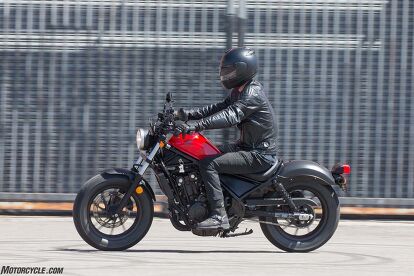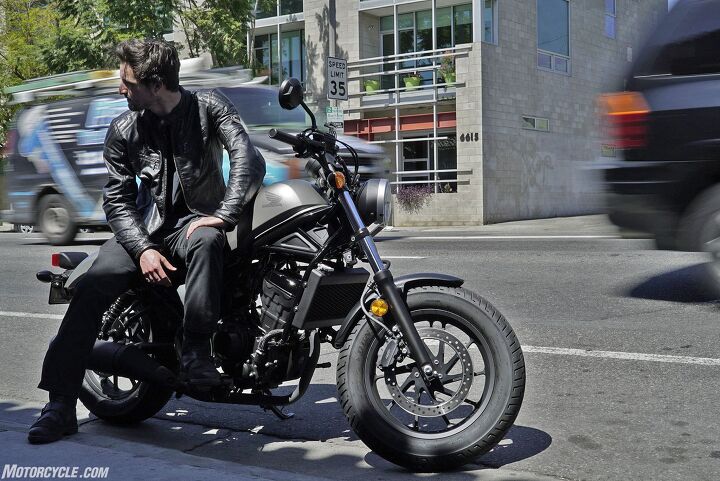2017 Honda Rebel 300 Review: First Ride
Honda's classic beginner bike gets a major upgrade
Before you begin wondering if you’ve taken your medication this morning, let me preface this review of the new 2017 Honda Rebel 300 with the fact that it will share a lot of thoughts and observations with last week’s review of the Rebel 500 that was introduced simultaneously. These two bikes share everything in common, except for the sewing machine some little old lady left inside the chassis of the 300.
2017 Honda Rebel 300
| Engine | 16.0/20 |
| Suspension/Handling | 10.5/15 |
| Transmission/Clutch | 9.0/10 |
| Brakes | 8.0/10 |
| Instruments/Controls | 4.0/5 |
| Ergonomics/Comfort | 9.0/10 |
| Appearance/Quality | 8.5/10 |
| Desirability | 7.0/10 |
| Value | 8.5/10 |
| Overall Score | 80.5/100 |
2017 Honda Rebel 300 Review: First Ride
The Rebel 300 is 2017’s closest relative to the classic, approachable, and affordable Rebel 250 that motorcyclists have become familiar with since its debut in 1985. The Rebel is known by many as the bike they learned on, may have even taken that special girl to prom on, but most importantly triggered their passion for bikes. The Rebel 300 carries on the “my-first-bike” torch starting at a very reasonable $4,399 for the base model, and $4,699 with ABS.
Honda designed the all new Rebel to be a blank canvas for new riders to customize and make their own, which is largely responsible for the Rebel’s minimalist, bare-bones styling. From the blacked-out components, the classic single large round LED headlight, the angled teardrop tank, and the exposed trellis frame, Honda has taken the Rebel in a new direction that I am a fan of. Honda decided not to simply make a miniature cruiser, lead engineer Keita Mikura pointed out, but an approachable bike that shares its styling with big-boy cruisers, including its wide 130/90-16 front tire and 150/80-16 rear with bikes like the Indian Scout.
If we’re talking customization, I would go ahead and remove the full steel rear fender that was purposefully designed by Honda to be easily disposed of via few bolts, giving it the complete bobber look that the kids sure do love these days, as well as add some clip-ons because dammit, I think that would look cool. Color options for the standard Rebel 300 are Matte Pearl White, Matte Silver Metallic, Black, and Red, and puzzlingly only Black for the ABS model.
In addition to the facelift, the Rebel 300 has gotten an overdue performance upgrade bringing it into the modern fuel-injected era. Instead of the old air-cooled carbureted 250cc Twin that barely chugged your prom date uphill, the Rebel 300 gets its mojo straight from the CBR300R, a fuel-injected liquid-cooled 286cc Single with four valves-per-cylinder, tuned for the Rebel to deliver better bottom-end power than its sportier cousins and surprisingly capable of huffing up a pretty sweet growl even with the stock exhaust. You’ll be thankful for the claimed 71-mpg fuel efficiency, allowing a range of 210 miles on the 2.96 gallon tank the Rebel is equipped with.
Compared to the Hyosung GD250 I sampled a few weeks ago, the Rebel is light years ahead in its transmission, and, well, its overall quality. A Rebel 300 rider winds up shifting a lot, flying up through the gearbox from every stop, with first gear barely making it through 15 mph. I could see this bike being great for meek beginners or for simply putting around town. Highway speeds are pushing it but do-able, and with its comfort and handling, the Rebel 300 holds its ground. Still, I’d try to find the extra $1,600 for the more capable Rebel 500.
The neutral riding position fits well with this bike’s overall goal of approachability. I thank my lucky stars Honda had the sense to avoid the tailbone-crunching outstretched cruiser peg position, and that the bars have been positioned in a natural location that has the arms out straight with a slight elbow bend. All together the Rebel’s ergonomics and stature with its low 27.2 inch seat height will fit most riders well and provide plenty of comfort.
Even after gaining the 33 pounds along with 52cc from the Rebel 250’s specs, the Rebel 300 feels light and nimble. It shines when riding through heavy L.A. traffic and tight parking lots, feeling stable and easily maneuvered, but also keeps steady and confident at highway speeds. That is until the uber-soft suspension hits a series of bumps and begins bobbing away, even scraping pegs when cornering hard and pushing the ol’ girl. The Rebel is a great handling bike that is held back by its soft suspension, but then again, the type of rider to push the 300 to such a point isn’t exactly the Rebel’s target audience, and the softness is appreciated at slower speeds providing a cushy ride on the 4.8 inches of front travel on the 41mm front fork, and the 3.8 inches of travel from the rear shocks.
Along with the engine, the Rebel has gotten a braking upgrade as you can now find disc brakes at the front and rear compared to the previous generation’s front disc and rear drum brake. With the Rebel’s relatively light weight, and Honda’s high standards even for its “affordable” bikes’ components, the brakes work great and provide plenty of stopping power.
With the Rebel’s target audience in mind, and Honda’s high standards for finish quality and ease of use, the Rebel 300 is a great package for new riders looking for a tame, comfortable, and maneuverable cruiser to gain their confidence on.
2017 Honda Rebel 300 Specifications | |
|---|---|
| Engine Type | 286cc liquid-cooled single-cylinder four-stroke |
| Bore And Stroke | 78mm x 63mm |
| Induction | PGM-FI |
| Ignition | Full transistorized ignition |
| Compression Ratio | 10.7:1 |
| Valve Train | DOHC; 4 valves per cylinder |
| Transmission | Six-Speed |
| Final Drive | O-ring-sealed chain |
| Front Suspension | 41mm fork; 4.8 inches travel |
| Rear Suspension | Dual shocks with 3.8 inches travel |
| Front Brake | Hydraulic disc |
| Rear Brake | Hydraulic disc |
| Front Tire | 130/90-16 |
| Rear Tire | 150/80-16 |
| Rake | 28°0′ (Caster Angle) |
| Trail | 110mm (4.3 inches) |
| Wheelbase | 58.7 inches |
| Seat Height | 27.2 inches |
| Curb Weight | 364 pounds (Includes all standard equipment, required fluids and a full tank of fuel-ready to ride) |
| Fuel Capacity | 2.96 gallons |
| Emissions | Meets current EPA standards. California version meets current CARB standards and may differ slightly due to emissions equipment. |
| Available Colors | Matte Pearl White, Matte Silver Metallic, Black, Red |
| Warranty | One year Transferable, unlimited-mileage limited warranty; extended coverage available with a Honda Protection Plan |
More by Ryan Burns













































Comments
Join the conversation
WTH? Does anyone publish HP and top speed specs anymore?
what is the maximum lean angle for this bike?